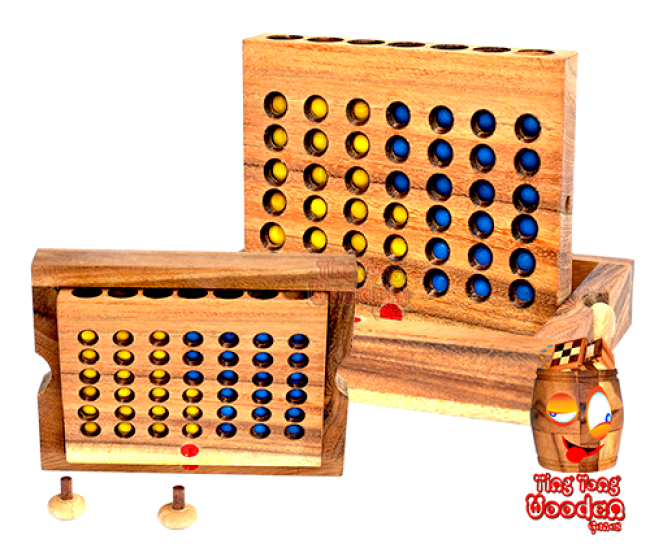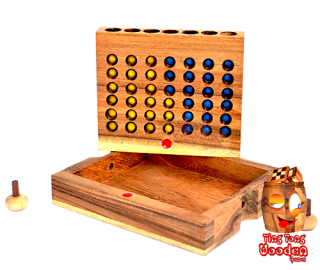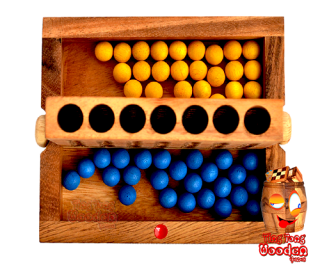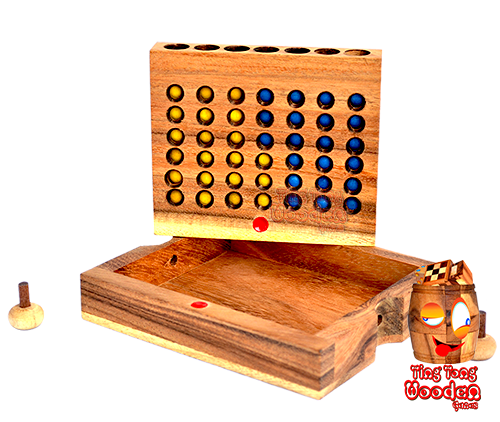 Four Wins as wooden version for the trip Bingo take away play us wooden in Samanea Wooden
Four Wins as wooden version for the trip Bingo take away play us wooden in Samanea Wooden
connect four small strategy game



Connect 4 wooden box small
 Here as Samanea wood box version with wooden balls. The box can be assembled together for transport. To prepare the Samanea wooden box for the game, please pull the 2 pins left and right out of the game and remove the board from the frame. When opening, make sure that the 2 red dots point downwards because otherwise all the balls fall out.
Here as Samanea wood box version with wooden balls. The box can be assembled together for transport. To prepare the Samanea wooden box for the game, please pull the 2 pins left and right out of the game and remove the board from the frame. When opening, make sure that the 2 red dots point downwards because otherwise all the balls fall out.
This also applies when building together, red points together pointing down the wooden game put together. Insert the playing field into the wooden frame and insert the bingo game into the frame, now as a base plate. Once the game has been set up and everyone has his balls of the selected color in his compartment, you're off.
Start of the strategy game Four Wins
 The four-in-a-row wooden game is played with a vertical hollow board, into which players alternately drop their pieces. The game board consists of seven columns (vertical) and six rows (horizontal). Each player has 21 same colored tiles which are set alternately by the players of the Four Winning Strategy game.
The four-in-a-row wooden game is played with a vertical hollow board, into which players alternately drop their pieces. The game board consists of seven columns (vertical) and six rows (horizontal). Each player has 21 same colored tiles which are set alternately by the players of the Four Winning Strategy game.
When a player drops a tile into the Bongo Wooden Game, it occupies the lowest available space in the column. The pieces are placed individually and alternately in the four-win game. The winner is the player who first manages to line up four of his tokens horizontally, vertically or diagonally. The game ends in a draw when the board is completely filled without a player has won.
Strategy and tactics for the 4-win game
Beginners often overlook simple enemy threats to complete foursome lines, so it's important to keep an eye on all vertical, horizontal and diagonal lines.
 Advanced players try to win by building two threats simultaneously (Fork). As a rule of thumb, checkers in the middle of the board have more value than tokens on the edge of the board because they give them more ways to participate in queuing lines (and thus limit the opponent's ability). Good players try to line up three tiles at short notice while preventing the opponent from placing in a particular column. Towards the end, the game often turns into a complex scoring game; both players try to win by trying to get the opponent to put in a certain column. In this situation, it is helpful to remember that when you play yourself, you always place an even number of pieces until you are back on your own. The strategies of the first and second player differ significantly. All the triads of a color create a hole: a field that triggers victory, operated by the corresponding player. A hole is called odd or even, depending on which row it is in (the bottom row is numbered "one"). For the first player to win, he must have built more odd holes than his opponent, the straight holes are not important. For the second player to win, he must have at least two odd holes more than his opponent, or the same number of odd holes and at least one straight hole. These rules are simplified, because if multiple holes in the same column, it will be more complicated. Holes that lie directly above other holes are mostly useless.
Advanced players try to win by building two threats simultaneously (Fork). As a rule of thumb, checkers in the middle of the board have more value than tokens on the edge of the board because they give them more ways to participate in queuing lines (and thus limit the opponent's ability). Good players try to line up three tiles at short notice while preventing the opponent from placing in a particular column. Towards the end, the game often turns into a complex scoring game; both players try to win by trying to get the opponent to put in a certain column. In this situation, it is helpful to remember that when you play yourself, you always place an even number of pieces until you are back on your own. The strategies of the first and second player differ significantly. All the triads of a color create a hole: a field that triggers victory, operated by the corresponding player. A hole is called odd or even, depending on which row it is in (the bottom row is numbered "one"). For the first player to win, he must have built more odd holes than his opponent, the straight holes are not important. For the second player to win, he must have at least two odd holes more than his opponent, or the same number of odd holes and at least one straight hole. These rules are simplified, because if multiple holes in the same column, it will be more complicated. Holes that lie directly above other holes are mostly useless.
So much fun, but beware the game has addictiveness !!!











